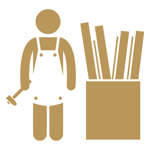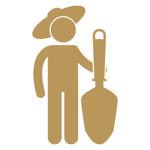Located in Nelsonville, Ohio in the heart of the Hocking Hills, sits Robbins Crossing Historical Village, a hub of history that reenacts what life was like in Southeastern Ohio from 1830 until 1880.
Robbins Crossing hosts programming and events throughout the year designed to share a love for Appalachian arts, crafts, and culture. Previous events have included Blacksmithing Workshops, Basket Weaving Classes, and Log Cabin Building Techniques. Robbins Crossing has also hosted other events such as the Nelsonville Music Festival, Hocking College Homecoming and Thunder in the Valley.

The General Store, originally constructed in 1867, was donated to Robbins Crossing in 1995 by the Franklin County Engineers Office. The store, also known as the Kidner House, serves as a center for refreshments and handmade crafts from local artisans.
Visitors can purchase various products from our General Store.

Constructed by Frank Bryant and David Spencer, owners of “Old Kentucky Homes”, and hand hewed with Poplar, Cooper's (also known as Woodworking) Shop was built in 1987. This was one of two trade workshops built on-site by community volunteers and students.
Coopers were skilled at making buckets and barrels as well as tool handles, kitchen wares, and other useful items.

The first blacksmith shop was built and furnished at Robbins Crossing in 1988 with the help of community volunteers, students and several area businesses.
These businesses included the Youth Civilian Conservation Corps, Southern Ohio Forge and Anvil Association, Logan Clay Products, Brooks Shoe Company and Hixson and Sons Construction.

The School House, once a log home, was built in the early 1830's and was donated by the McInterf family in 1995. Originally built in Morgan County, it has been used as a post office, an inn, a school, and even a barn.

The Wolfe House was built in the early 1830's on Lake Hope Drive near Nelsonville, Ohio. It was donated to Robbins Crossing in 1987 by the Wolfe family.
This house is used to demonstrate frontier toys and games, laundry and other home crafts and skills.

The Gladden House was built in 1842 in Wildcat Hollow near Corning, Ohio. It was lived in by the Gladden Family until 1984 when they donated to Robbins Crossing in 1987.
This impressive two-story house serves as Robbins Crossing's kitchen, gathering place, and community center.

The Anthony House was the first log structure to be moved to Hocking College. This "double" log home was built around 1825 near Union Furnace, Ohio.
Threatened with destruction by coal strip mining, it was donated by the Anthony family and moved to its current location in 1978. Frontier crafts and skills are demonstrated here.

The Gibbons' House, also referred to as Doctor's Cabin, was built around 1848 and was donated by the Gibbons family of Millfield, Ohio.
It is now used to demonstrate 19th-century medical practices and medicinal herbs.

The Gardens at Robbins Crossing include 5 vegetable, 2 pollinator, and 2 medicinal plots as well as various flower plantings.
Vegetables grown include turnips, cabbage, beans, potatoes, onions, beets, cucumbers, pumpkins, squash, sweet corn, AND MUCH MORE!

While visiting Robbins Crossing Historical Village, guests might encounter pigs, turkeys, ducks, chickens, cats, turtles, and snakes.
These animals are cared for by the Parks and Museum Education and Agroecology students.
Since its inception, the Parks and Museum Education Program at Hocking College has become renowned for training experienced, confident and talented educators.
As a student in the Parks and Museum Education Program, you will be trained to educate others about the environment and human connections to it.
Classes use the backdrop of Southeastern Ohio to extract stories of interest in the natural world and the history of nearby areas. Emphasis is placed on practical experience, leading programs with groups of all kinds, exhibit design and development of interpretive sites. You will also receive unique training in researching and developing living history subjects and techniques.
Agroecology uses the study of ecology to evaluate the productivity of agricultural systems. This includes the dynamics between technological advances, biophysical interactions, socioeconomic relationships, and the geology/geomorphology of a region.
Use of local resources, conservation and preservation of the environment and efficiency (saving both money and resources) are the goal for success in farming via Agroecology. This is ideal for a small farm in areas that may suffer economically or have limited natural resources (due to over-use, difficult terrain, or small parcels of land available).
Choosing unique crops or animals, such as varieties of hops, heirloom seed varieties, organic crops, antibiotic-free livestock (goats, sheep, emu, cattle), wool (sheep, llama, alpaca), winter-hardy grapes (that can be sold to local wineries) are all examples of the interesting and profitable choices for small farming.